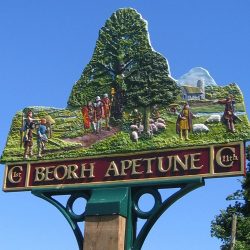‘Spring goeth all in white,
Crowned with milk-white may;’
Robert Bridges
Almost over night it seemed Spring had spelled the hawthorn tree in the hedge and great clouds of white blossom ruffed its branches. The notched leaves witched to a bright leathery green. The anthers are red, like the head of a match, so each flower resembles a speckled bird’s egg. Now, in mid-summer, clutches of small green berries hang on tightly and, as summer ages will, like traffic lights, turn to amber and then red. This is not the enamelled red of rowan berries or the polished sheen of rose hips but a modest, sombre red. Old ballads and legends tell that the hawthorn is a tree of mystery and enchantment, a faerie tree. It is said the crown of thorns with which Christ was mockingly crowned was made from hawthorn. In the Lady Chapel at Ely there is a carving showing Mary with her Child set against a background of hawthorn leaves. Mary holds one haw, a sign of what is to come for the Child. At some Palaeolithic cave dwellers burial sites, the bodies have been found wearing similar crowns of hawthorn.
Mary’s uncle, Joseph of Arimathea, was a merchant trading in tin and, so the stories go, he came to our ancient kingdom, to the West Country to do business with the tin miners. On one occasion, at least, he brought his great nephew, the Boy Jesus with him and this story was known to William Blake, hence the opening words in ‘Jerusalem’,
‘And did those feet, in ancient time
Walk upon England’s mountains green?
And was the Holy Lamb of God
On England’s pleasant pastures seen?
Glastonbury is an ancient town in Somerset and another legend is that Joseph of Arimathea came here after the Crucifixion of Christ and brought the Cup used at the Last Supper, the Holy Grail of Arthurian legend, with him. He was tired and distressed after his long journey to reach this land. He paused to sleep and thrust his staff into the ground beside him, the hand that held it had smoothed precious oils into the body of Christ when it was taken from the Cross. It took root and every year at Christmas it burst into leaf and flowers. It is the humble hawthorn, quickthorn or whitethorn which, in bleak winter, flowers to greet the coming of the Light not the exotic rose or lily. A sprig from the Holy Thorn is sent to the Queen every year so she has it on her table at
The hawthorn tree is believed to be a dwelling place for faeries and an entrance to their country. An ancient ballad from the Borders tells how Thomas the Rhymer or, True Thomas as he is known, sat under a hawthorn , known as the Eildon Tree and the Queen of Faeries rode by in a dress of ‘grass-green silk’ and on her steed’s mane ‘hung fifty silver bells and nine’. She dares him to kiss her lips and, of course, he does.
She carries him off as he must now serve her. In Elfland she offers him food which he eats and, as we all know, one must never, never, never, eat food offered by the Little People. When he returns he thinks he has only been away for a day instead of seven long years. It is believed he lives on in the hollow Eildon hills. So do not sit under a hawthorn tree unless you have the protection of a twig each of oak, ash and hawthorn bound together by a red ribbon, as one never knows who might come
Westminster Abbey is built on what was known as Thorney Island in the River Tyburn and named after a sacred stand of hawthorn trees. Edward the Confessor built a church here and the present building altered and added to by other monarchs was built originally by Henry 111 in 1245.
The Hawthorn is also known as May as this is when it flowers. There is the nursery rhyme, ‘Here we come gathering nuts in May’. This should read as ‘knots’ not ‘nuts’. Sprigs and bunches of hawthorn were gathered in days gone by and even in some places nowadays to celebrate the Merry Month of May.’
Henry vii chose the hawthorn as his emblem after the Battle of Bosworth as the crown worn by Richard iii as he rode to battle was found in a hawthorn after Richard was killed. Henry, the first of the Tudor dynasty, received this crown on what is known as Crown Hill.
A small tree, a hedge tree, gnarled, twisted and thorny, crabbed. It bends and knots, spiky bones knitted together against wind and weather.
